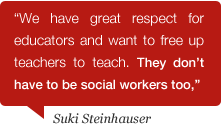In a city that vibrates with the energy and creativity of young adults, would it surprise you to learn that 20-somethings are not the fastest growing segment of Austin’s population? OK, what about 30-somethings? Keep going … forward and backward too … yes, in the past decade, the fastest growing age groups in Austin are mid-age adults (45-54) pre-seniors (55-64) and seniors (65+) at one end of the spectrum, and children under five-years-old at the other.
In fact, City of Austin demographers tell us that, between 2000 and 2010, growth in all other age groups actually declined.
Now, consider what this means to Austin: The groups that require the most community services are growing faster than the groups that generate the monies (public and private) that pay for these services.
The shift in population we face requires careful planning, but it also presents compelling opportunities to foster a vibrant multi-generational community. Two local organizations cultivating the assets among our youngest and oldest are Communities in Schools of Central Texas, committed to helping “under-fives” achieve school readiness, and Family Eldercare that supports a growing senior population’s desire live independently for as long as possible.
 Communities in Schools focuses on at-risk youth
Communities in Schools focuses on at-risk youth
Communities in Schools’ (CIS) mission is to empower young people to stay in school and graduate. That work begins earlier and earlier as youth experts now know that disengagement from school is a multi-year process, sometimes beginning in kindergarten. CEO Suki Steinhauser said the increase in under-fives calls for a strong focus of energies and resources on behalf of at-risk boys and girls, and that the Austin community has “robustly” embraced working with these little ones and their families.
“We look at this big group as a big opportunity. In the education and social service communities, we all understand that there is a magnified effect when children’s needs are met or not met,” she said.
Steinhauser profiled the young children that CIS works with. Most are Texas-born into low-income families, she said, and for many, English is not spoken at home. Developmental delays are common. “When many of these children enter kindergarten, they are not prepared for the work due to a variety of external circumstances. Then the pattern of academic struggle begins and becomes rooted for them. They struggle more each year, and by the teen years, they drop out of school,” Steinhauser said. And the number of potential dropouts in Central Texas is staggering — more than 100,000 kids are at risk of not graduating.
According to the "Success by 6" initiative of United Way for Greater Austin, only one of two students in Travis County enters kindergarten prepared for success. More striking, in neighborhoods with many disadvantaged families, as few as 13 percent of children are ready for kindergarten, and current birth records show that these neighborhoods are growing more rapidly than more prosperous ones.
Because Central Texas school districts are seeing increased numbers of youngsters and families who need help, the CIS model puts full-time staff in schools to work with students who have non-academic barriers to learning. CIS social workers and school personnel work closely together to provide and coordinate an array of social services unique to the needs of children and their families. This may include crisis intervention, individual counseling or support groups, life skills training, tutoring, literacy assistance, mentoring, or enrichment opportunities.
“We have great respect for educators and want to free up teachers to teach. They don’t have to be social workers too,” Steinhauser said.
 CIS operates on 54 campuses—21 are elementary schools—in six school districts—Austin, Hays, Lockhart, Bastrop, Del Valle and Manor. In 2010-2011, almost 56,000 students were served—close to 7,000 of them intensively.
CIS operates on 54 campuses—21 are elementary schools—in six school districts—Austin, Hays, Lockhart, Bastrop, Del Valle and Manor. In 2010-2011, almost 56,000 students were served—close to 7,000 of them intensively.
“Experience shows us that dropping out is not a one-time event. Rather it is a process of school disengagement that may begin in pre-school,” she said. “Our goal with the little ones is to involve the family in services. We’re strong proponents of parent education and home visits. The home environment is the child’s greatest influencer, and that’s where we can get at the core of a problem and offer help most effectively.”
Steinhauser said the agency also partners with nearly 100 organizations — non-profit, faith-based, universities, corporate, and civic groups — to help the highest-need kids. CIS is supported by public and private monies, although cuts in state funding have required the agency to “work hard to recover” losses. Private funding comes from United Way, grants, and the agency’s own fundraising.
Get Involved with Communities in Schools
![]()
 Family Eldercare braces for Silver Tsunami
Family Eldercare braces for Silver Tsunami
Serving the other end of the life continuum is Austin’s Family Eldercare, which provides services and support to elderly persons and their caregivers.
One statistic says volumes: In the past decade, Austin’s elderly population grew by 27 percent, twice the national rate. Austin’s Baby Boomers — the oldest are turning 66 this year — are beginning to put heavier demands on community services for the elderly, and that will increase exponentially over the next two decades. This growth has been tagged a Silver Tsunami, and experts in care for the elderly agree — Austin is unprepared.
Family Eldercare CEO Angela Atwood is excited about the new Task Force on Aging that will be convened on September 20 by Austin Mayor Lee Leffingwell. The collaborative effort will bring together a cross-section of community stakeholders in elderly care and life issues. She believes that its work can be an important first step in identifying and implementing strategies that will build on Austin’s assets for the elderly and strengthen its infrastructure of senior living.
“The timing is perfect,” she said. “It’s time for a serious community conversation about the needs of our elderly.” And with the aging of the huge baby boom population, “time to construct a plan to meet them.”
 The issues this senior boom present are complex and multi-layered. Housing, transportation, medical care, food insecurity, living assistance, poverty, and mental health are primary concerns. Yet, Atwood says that “unbelievable opportunities” exist for the community to enrich the care of its oldest and increasingly fragile citizens.
The issues this senior boom present are complex and multi-layered. Housing, transportation, medical care, food insecurity, living assistance, poverty, and mental health are primary concerns. Yet, Atwood says that “unbelievable opportunities” exist for the community to enrich the care of its oldest and increasingly fragile citizens.
“We talk about the joy of aging, its grace and dignity,” she said. “All those things can certainly exist in a person’s last years if the supports are there.”
These supports are the core of Family Eldercare’s work. Its efforts focus on helping seniors “age in place,” by staying in their own homes, living independently for as long as possible. Programs include in-home care and caregiver services, guardianship, money management, and geriatric consultation and counseling. Carefully-screened and highly trained Care Attendants provide daily assistance with things like bathing, dressing, medication reminders, meal preparation, transportation to appointments and other support to allow the senior to remain in their homes. Staff also conducts home checks for safety issues in hopes of preventing falls and premature moves to nursing homes.
Annually, Family Eldercare works with approximately 5,500 older adults in long-term relationships that can span years. “Ideally, we begin working with a senior early on. Early help can change the aging trajectory significantly,” Atwood said. Fees are based on a sliding scale.
The agency assists caregivers who are frequently relatives also committed to jobs and families. Atwood said that one in four Austin households is caring for an aged adult. That can lead to unpaid absences from work, lost career opportunities, lower wages, and family conflict — and caregivers themselves suffer from high levels of stress, chronic disease and depression.
“As we decline in mobility, memory, health, strength, and capacity, we all need additional help from someone who can provide it with honesty and dignity,” she said. “But the stress of caregiving is immense. It’s a difficult responsibility and caregivers often feel alone.”
Planning for aging is important. Atwood recommends that families start discussing senior needs before they emerge and become difficult to meet or worse, a crisis.
“Aging surprises us. It’s the most unexpected thing of all, but it’s a fact of life for most of us. A prepared family will support their loved one at a quality of life that all seniors deserve,” she said.














